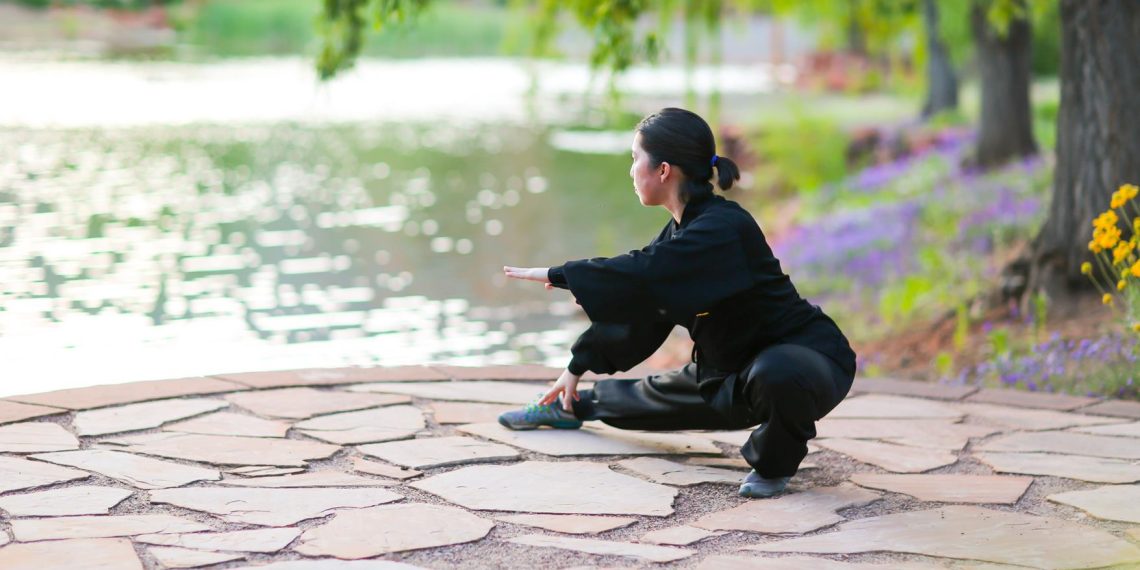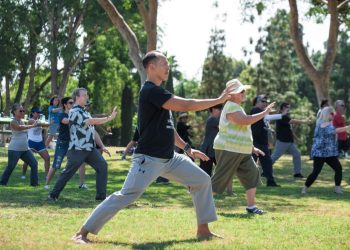There’s something profoundly transformative about practicing Tai Chi walking outdoors. Unlike the controlled environment of a studio or gym, the natural world offers an ever-changing canvas for your practice—one that breathes with you, moves around you, and invites you into a deeper communion with the rhythms of life itself. As you step mindfully through parks, gardens, or forest paths, you’re not just exercising; you’re entering into an ancient dialogue between body, mind, and the living earth beneath your feet.
Tai Chi walking, also known as walking meditation or mindful walking in the Tai Chi tradition, combines the gentle, flowing principles of Tai Chi with the simple act of walking. It’s a practice that strips away complexity while maintaining depth, making it accessible to people of all ages and fitness levels. When practiced outdoors, this deceptively simple activity becomes a gateway to profound physical, mental, and spiritual wellness.
The Unique Benefits of Taking Your Practice Outside
While Tai Chi walking offers benefits in any setting, practicing outdoors amplifies these effects in remarkable ways. The outdoor environment engages your senses in a multi-dimensional experience that indoor spaces simply cannot replicate.
Enhanced Breathing and Oxygen Flow
One of the most immediate benefits you’ll notice is the quality of air. Fresh outdoor air, especially in parks or natural areas, contains higher oxygen levels and fewer pollutants than indoor environments. As you practice the deep, diaphragmatic breathing central to Tai Chi, you’re filling your lungs with air rich in negative ions—naturally occurring molecules that research suggests may improve mood and energy levels. Each breath becomes more nourishing, supporting better circulation and helping to clear the mental fog that accumulates from indoor living.
Vitamin D and Natural Light Exposure
Practicing outdoors exposes you to natural sunlight, which stimulates vitamin D production in your skin. This essential nutrient supports bone health, immune function, and mood regulation. Even on cloudy days, outdoor light levels far exceed indoor lighting, helping to regulate your circadian rhythms and potentially improving sleep quality. The natural light also reduces eye strain and provides a visual rest from screens and artificial illumination.
Grounding and Earth Connection
The concept of “earthing” or “grounding”—the practice of making direct contact with the earth’s surface—has gained scientific attention in recent years. When possible, practicing Tai Chi walking barefoot on grass, sand, or soil allows electrons from the earth to enter your body, which some research suggests may reduce inflammation and stress. Even with shoes on, the simple act of walking on natural surfaces provides proprioceptive feedback that improves balance and engages stabilizing muscles more effectively than flat indoor floors.
Psychological Restoration
Nature has a documented restorative effect on mental health. Studies consistently show that time spent in natural environments reduces stress hormones, lowers blood pressure, and decreases symptoms of anxiety and depression. When you combine these effects with the meditative qualities of Tai Chi walking, you create a powerful synergy. The practice becomes a moving meditation that soothes the nervous system while the natural environment provides what researchers call “soft fascination”—gentle, effortless attention that allows the mind to rest and restore itself.
Finding Your Ideal Outdoor Practice Space
The beauty of Tai Chi walking is its adaptability to various environments. Each setting offers unique qualities that can enhance different aspects of your practice.
Parks and Open Green Spaces
Public parks are often ideal for beginners. They typically offer flat, maintained pathways that allow you to focus on your form without worrying about uneven terrain. The presence of trees, grass, and perhaps water features creates a peaceful atmosphere while still maintaining accessibility. Early morning or late afternoon practice in parks often provides the added benefit of quieter surroundings and beautiful natural lighting.
Forest Paths and Nature Trails
For those seeking a more immersive natural experience, forest environments offer something special. The Japanese practice of “forest bathing” (shinrin-yoku) has scientifically documented benefits, and combining this with Tai Chi walking creates a deeply therapeutic experience. The dappled light filtering through leaves, the soft give of earth beneath your feet, and the complex aromatics of the forest engage your senses fully. The slightly uneven terrain also challenges your balance and proprioception, deepening the mind-body connection.
Beaches and Lakeshores
Walking on sand provides unique physical benefits, offering natural resistance that strengthens foot and leg muscles. The rhythmic sound of waves creates a natural meditation aid, and the expansive views promote a sense of spaciousness in consciousness. Morning beach practice offers the bonus of watching the sunrise, while evening sessions provide spectacular sunsets. Just be mindful that soft sand can be challenging at first—start with firmer, wet sand near the water’s edge.
Gardens and Botanical Spaces
Formal gardens and botanical areas combine accessibility with concentrated natural beauty. The cultivated environment often includes interesting paths, varied terrain, and seasonal displays that keep your practice fresh and engaging. The aesthetic qualities of designed landscapes can inspire a sense of wonder and appreciation that deepens your meditative state.
Urban Green Corridors
Even in cities, you can find suitable spaces along riverfronts, in pocket parks, or on greenway trails. These urban oases provide necessary nature connection for city dwellers. While they may have more ambient noise, this can actually serve as practice in maintaining inner calm amid external activity—a valuable skill for modern life.
Working with Weather and Seasons
One of the joys of outdoor Tai Chi walking is experiencing the full spectrum of weather and seasonal changes. Rather than viewing weather as an obstacle, practitioners learn to work with it, finding lessons and benefits in each condition.
Spring: Awakening Energy
Spring practice connects you with the season’s rising energy. Cool morning air, blooming flowers, and the return of birdsong create an atmosphere of renewal. Light rain showers need not stop your practice—they can be refreshing and add a sensory dimension. Just dress in layers and consider water-resistant clothing. The dampness brings out earthy scents and intensifies colors, making spring walks particularly vivid.
Summer: Embracing Warmth
Summer invites early morning or evening practice to avoid peak heat. The full vitality of nature in summer—lush greenery, abundant wildlife, long days—energizes your practice. Stay hydrated and wear light, breathable fabrics. The warmth allows muscles to relax more easily, potentially deepening your stretches and movements. Light summer rain can be particularly pleasant, cooling the air and creating gentle percussion on leaves overhead.
Autumn: Harvesting Stillness
Autumn offers perhaps the most aesthetically dramatic practice environment. Crisp air invigorates your breathing, while the visual spectacle of changing leaves provides ever-shifting beauty. The slight chill encourages slightly brisker movement, warming you naturally. As leaves fall and crunch underfoot, you become more aware of each step, deepening mindfulness. Autumn’s inherent themes of letting go and preparation for rest resonate with Tai Chi’s emphasis on releasing tension and finding stillness.
Winter: Cultivating Inner Warmth
Winter practice is not for everyone, but those who embrace it discover unique rewards. Cold air requires deeper, more conscious breathing. The starkness of winter landscapes—bare trees, snow, frost—creates a meditative simplicity that mirrors the essential simplicity of the practice itself. Dress in layers you can adjust as you warm up. The contrast between the cold external environment and the warmth you generate internally demonstrates Tai Chi’s power to cultivate and circulate qi (life energy).
Wind and Its Teachings
Wind is often considered a challenge, but it’s actually a valuable practice partner. Gentle breezes provide sensory feedback, helping you feel your body’s position in space. Stronger winds test your root and stability, encouraging you to sink your weight and maintain your center—core principles of Tai Chi. Rather than fighting wind, practice moving with it, allowing it to inform your movements.
Connecting with Nature Through Mindful Walking
The true magic of outdoor Tai Chi walking lies not just in being outside, but in how the practice opens your awareness to the natural world.
Sensory Awakening
Begin each outdoor session with a moment of stillness, consciously opening your senses. What do you see, hear, smell, feel on your skin? As you begin walking, maintain this sensory awareness. Notice how light changes as you move under trees. Listen to the layers of sound—distant traffic, nearby birdsong, wind in leaves, your own footsteps. Feel temperature variations in sun and shade. This multi-sensory engagement pulls you fully into the present moment.
Walking as Reciprocity
Indigenous wisdom traditions speak of walking on the earth with awareness as an act of reciprocity—a way of honoring the land that supports us. Bring this consciousness to your practice. Feel your feet touching the earth not as mere mechanical contact, but as communication. With each step, you’re supported by the ground, while your mindful presence honors that support. This shift in perspective can transform your walk from exercise into ceremony.
Observing Natural Rhythms
Regular outdoor practice attunes you to nature’s rhythms. You’ll notice seasonal shifts in plant life, animal behavior, and light quality. You might observe the same tree through an entire year, witnessing its cycle of bloom, fruit, leaf fall, and dormancy. This observation naturally cultivates patience, acceptance of change, and awareness of life’s cyclical nature—all central to Tai Chi philosophy.
Breath Synchronized with Nature
Try occasionally synchronizing your breathing with natural movements around you—the sway of branches, the flow of water, or the rhythm of waves. This practice dissolves the artificial boundary between self and environment, creating a felt sense of interconnection. Your breath becomes part of the greater breathing of the natural world.
Practical Tips for Beginning Your Outdoor Practice
Start Simple
Don’t overcomplicate your initial outdoor sessions. Simply walk slowly and mindfully, focusing on weight shifts from foot to foot, maintaining relaxed shoulders, and breathing naturally. As this becomes comfortable, incorporate more Tai Chi principles like keeping your knees soft, maintaining an upright spine, and moving from your center.
Choose Appropriate Footwear
Wear shoes with flat, flexible soles that allow good ground contact and let you feel the earth beneath you. Trail shoes or minimal footwear work well. Save barefoot practice for smooth, safe surfaces like grass or sand until you’ve developed foot strength and awareness.
Be Flexible with Time
Even five minutes of mindful outdoor walking provides benefits. Don’t wait for the perfect 30-minute window—take what time you have. Regular brief sessions often prove more valuable than occasional long ones.
Practice Safety Awareness
While the goal is meditative absorption, maintain enough awareness to navigate safely, especially on trails. This balanced awareness—deeply present yet practically alert—is itself excellent practice.
Tai Chi walking outdoors is more than exercise; it’s a practice of coming home to yourself while simultaneously coming home to the natural world. In a culture that increasingly separates us from nature and from our own embodied experience, this simple practice offers restoration and reconnection.
As you make outdoor Tai Chi walking part of your life, you’ll likely find that the benefits extend far beyond the practice itself. The mindfulness cultivated on your walks may permeate your daily activities. The peace found in nature may become a resource you can access even in challenging moments. The strength and balance developed physically may manifest as emotional resilience and mental clarity.
The path forward is simple: step outside, breathe deeply, and begin walking with awareness. The natural world is waiting to support your practice, offering its beauty, its rhythms, and its ancient wisdom to guide you toward greater health, harmony, and wholeness.






